I’ve just started working on a new track for the Bee LP entitled “Drones.” Appropriately enough, it is (mostly) in an ambient style, with droning synthesizers.
A rough version is posted now on the album page for your interim enjoyment.

I’ve just started working on a new track for the Bee LP entitled “Drones.” Appropriately enough, it is (mostly) in an ambient style, with droning synthesizers.
A rough version is posted now on the album page for your interim enjoyment.
 My latest full-length album project is going to be entitled simply Room 34 but, honoring some of my favorite bands that have released self-titled (or untitled) albums, such as The Beatles, Led Zeppelin, Peter Gabriel and Weezer (and probably others I’m just not thinking of at this second), it has an unofficial title, based on the cover: The Bee LP.
My latest full-length album project is going to be entitled simply Room 34 but, honoring some of my favorite bands that have released self-titled (or untitled) albums, such as The Beatles, Led Zeppelin, Peter Gabriel and Weezer (and probably others I’m just not thinking of at this second), it has an unofficial title, based on the cover: The Bee LP.
For the first time since I began recording music in 1990, I’ll be putting out a release with cover art not designed by me. The cover art was drawn by my five-year-old son, Fletcher. It also serves as inspiration for the music on the album… or at least for the titles of the songs, each of which will be bee-themed.
Learn more at the album’s official page!
And it’s not just type case.
As I’ve mentioned, I have taken a shine to Amazon MP3 as my primary source for music downloads now. Sorry, Apple. You know I love you, but Amazon’s just doing it better. Better selection, better prices, and usually better quality. Plus everything’s MP3, not AAC. And no DRM, ever.
And while I don’t anticipate ever switching media players (the iPod and iPhone have served me well, even if you’ve been stumbling a bit lately). My new car’s CD player supports MP3 (and, ugh, WMA) CDs, but not AAC. And yes, I keep an iPod nano in the car (note to potential thieves: no I don’t), but it’s still convenient to load up several albums’ worth of music onto a single CD and pop it in. No annoying cords or dangerous behind-the-wheel iPod fiddling.
So anyway… yeah, Amazon MP3. And MP3s in general.
I’ve ripped my entire CD collection multiple times. First, back in 2001 or so, I ripped it all as 128 kbps MP3s. Then I got to the jazz CDs and noticed how bad 128 kbps actually sounded on some music. So I re-ripped the whole collection as 192 kbps MP3s. That was the smallest size where I didn’t really notice bad audio artifacts.
Then in 2004 Apple introduced the iTunes Store, and with it everything was 128 kbps AAC, Apple’s own, semi-proprietary format. Better compression-to-quality ratio, so 128 kbps AACs sounded as good (to me) as 192 kbps MP3s, at 2/3 the size. So I went back through and started ripping my CDs again, this time as 128 kbps AAC format.
Then last year Apple introduced iTunes Plus, with 256 kbps AAC format. Sure, they’re twice the size, but now I really can tell almost no difference between the compressed versions and uncompressed CD quality. So I started ripping again, but honestly I could not tell the difference between 256 kbps AAC and 160 kbps AAC, but I could tell the difference between 128 and 160. So 160 was my new standard. I only made it through about a quarter of my CDs at this new level though.
Then this year we had the release of my own music on some download sites, and I went with 256 kbps MP3 for those. Combine that with my new embrace of Amazon and their use of 256 kbps MP3 as well, and that pretty much sealed it. 256 kbps MP3 is my new format of choice, and I’m going through my entire CD collection and ripping it yet again in this format.
Which brings me to the whole point of this post. When you put a CD in your computer, iTunes (or whatever ripping software you’re using) grabs CD track information from CDDB. This data is submitted by users. Sometimes if you insert a new release or a really obscure album into your computer, it will tell you that track info could not be found, and it presents you with the opportunity to submit information you’ve entered. Which means any typos or other idiosyncrasies in your own personal way of entering this information will now become what anyone else who inserts the same CD into their computer will see, provided they’re lazy enough not to fix your dumbass mistakes. I’ve grown accustomed to fixing band names, correcting spelling, normalizing title cases (You Don’t Capitalize Articles, Conjunctions or Prepositions in Titles, but It Is Correct to Capitalize Pronouns and Verbs, Even If They’re Only Two Letters Long, Thank You Very Much), etc.
But something I’ve noticed from time to time, and never quite got, really bothers me. First off, I think the BPM field is pretty much useless. Unless you’re a DJ and you actually know the tempo of the songs you’re working with, you have absolutely no need for this field. But sometimes I see it filled in, and with the same value for every track on an album. Highly unlikely. It’s just finally dawned on me over the past few days why this is, though, and it’s because I’ve only ever seen two values in that field: 128 or 192. The same idiots who can’t spell also can’t tell the difference between BPM and kbps.
So, let’s have a little acronym lesson, shall we?
BPM (Beats Per Minute): The “tempo” or, if your musical knowledge is severely lacking, “speed” of a piece of music. How many beats (you know, the part of the music that helps you dance) there are in a minute.
kbps (kilobits per second): This is the amount of data in the compressed (MP3, AAC, WMA or whatever) file per second of music. In other words, it’s the compression quality of the audio file, quantified.
And now you know… the rest of the story.
 Don’t tell SLP, but I’m in love. It happened this afternoon at the new Best Buy at the Mall of America. No, it’s not an affair. It’s a Jaguar Bass.
Don’t tell SLP, but I’m in love. It happened this afternoon at the new Best Buy at the Mall of America. No, it’s not an affair. It’s a Jaguar Bass.
I’ve been planning to buy a new bass for several months now. My standard Fender Jazz is OK but it’s just not cutting it. The pickups are the big problem. Too buzzy. And one of the volume pots slips. I took off the cover plate and tried to tighten it, but I couldn’t. It’s a fine bass, but I just want something better. I got spoiled when I had an American Jazz Bass a few years ago. So I’ve been planning to upgrade to the Deluxe Jazz. Not quite as nice (or as expensive) as the American, but it has the same Made-in-USA pickups, plus active electronics, at a more reasonable price. And of course it is a 5-string, which has become second nature for me.
So as much as I was dazzled from the first time I saw it a few years ago by the Jaguar’s overwhelming array of switches, knobs and dials, the fact that it doesn’t come in a 5-string model was always a deal breaker for me.
But as long as I was there at Best Buy today, and it was too, I figured, why not just pick it up and try it? Big mistake. Before I even plugged it in, I could tell what it was going to sound like, and that I was, like, totally going to want it! And I did.
The sales dude really knew how to work it too. He was friendly and helpful from the get-go, and then he backed off and just let me play. After a couple of minutes of noodling around and testing the intonation across the fretboard (the next most critical thing about a bass after good pickups), I started playing a bit of the bass line from my favorite Yes song, “Heart of the Sunrise.” A minute later, “Roundabout” started playing on one of the PA demo units across the room. Wrong song, but right album. Kudos to him. If I do get the Jag (which seems more likely with every passing second as I write this), I’ll probably go back there for it. And he doesn’t even get a commission!
It doesn’t have 5 strings, but it sounds great and it looks great (and it comes from Fender’s Japanese shop, which is second only to the one in Corona, California for quality, at a significantly lower price), and it’s pretty much the same price as what I was planning to pay for the Deluxe Jazz. Good deal! (Of course, I also want to get a microKORG, but maybe I can kill two birds with one stone.)
OK, first off let me say that I have finally arrived at an age where I can honestly and without shame say that, no sir, I just don’t really like A Prairie Home Companion that much. And that’s a tough statement to make as a born-and-bred die-hard self-styled intellectual liberal Minnesota DFLer. (That’s Minnesota’s slightly-more-liberal-and-even-more-union-friendly flavor of the Democratic party.) And I think the thing I dislike most about the program, more than Garrison Keillor’s meticulously cultivated faux-folksiness is the nauseating preponderance of jazz violin in the featured music. I hate jazz violin. (And I love the fact that it has yet to earn its own Wikipedia entry.)
Well, I’ve been working on some new music. In the spirit of the title of a track from the latest Joe Satriani album, I’m currently calling it “Dun Dun Tsh.” And right now I am really enjoying it because it’s drowning out the jazz violin that’s currently playing at the Caribou Coffee where I’m sitting as I write this. I’m not really sure how I’d classify this music, but it’s definitely inspired by the “electronic breakbeat jazz” work of Revolution Void.
Once I have a finished version I plan to release this as part of a new series of free downloads distributed under Creative Commons licensing.
For now, here’s a rough mix for you to enjoy. I said enjoy!
[audio:http://blog.room34.com/wp-content/uploads/underdog/dun-dun-tsh-03.mp3]